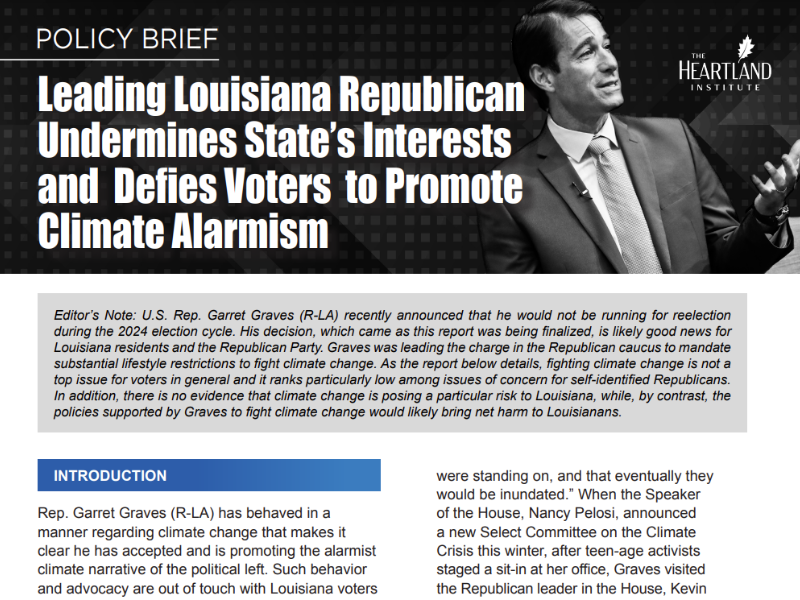Global warming alarmists are up in arms about the Wall Street Journal publishing a letter from 16 scientists explaining there is “no need to panic about global warming.” The letter, published January 27, points out there has been no global warming during the past decade, explains carbon dioxide is not a pollutant, and notes prescribed solutions to global warming do not pass a cost-benefit test.
On February 1, the Journal published a response signed by 38 scientists. The response claims an overwhelming percentage of scientists believe global warming is real and humans are primarily responsible for the warming. The response also claimed most of the 16 scientists who wrote the initial letter have no climate science expertise.
Ironically, the 38 signatories of the alarmist response appear to have less expertise than the signatories of the initial letter. The response is signed by such people as Peter Gleick (head of an environmental activist group whose advanced degrees are in “Energy and Resources”), Terry Root (a biologist with no apparent formal training in climate science), Steven Running (a forester with no apparent formal training in climate science), etc.
The alarmist response presents no scientific arguments and relies instead on an appeal to alleged consensus and alleged scientific authority. Even here, however, the alarmists present little of value.
The appeal to consensus asserts most scientists believe the Earth has warmed and humans are partly responsible. Such an assertion, however, says nothing about whether humans are causing a global warming crisis (as opposed to causing warming that is beneficial, neutral, or only minimally detrimental to human welfare).
The appeal to authority asserts that the National Academy of Sciences have clearly stated that some warming has occurred and humans are primarily responsible. As I documented in a Forbes.com article last year, however, the National Academy of Sciences panel referenced by the alarmists was comprised of fewer than two dozen participants. Only five participants Ph.D.s in a field closely related to climate science. The panel lacked objectivity, as nearly all participants had already publicly asserted the existence of a global warming crisis before being chosen to participate in the panel. There were as many environmental activist staffers on the panel as there were scientists with a Ph.D. in a climate-related field.
If the alarmists are going to make scientific expertise the focus of their attacks on skeptics, they would be wise to remember that people living in glass houses shouldn’t throw stones.
IN THIS ISSUE
Global temperatures plunge in January … Evans presents the skeptic’s case … Survey finds skeptics better informed than alarmists … Meteorologist puts “97 percent” in perspective … Environmental activist turns global warming skeptic … Carbon dioxide compared to bombing of Hiroshima … Climatewiki update
GLOBAL TEMPERATURES PLUNGE IN JANUARY
Global temperatures dropped 0.2 degrees Celsius last month and have dropped more than 0.4 degrees Celsius since late 2011, according to NASA satellite data. Global temperatures in January were below the 30-year average.
SOURCE: Dr. Roy Spencer
EVANS PRESENTS THE SKEPTIC’S CASE
Australian scientist David Evans has published a powerful, succinct, and easy-to-understand scientific summary of why global warming is not a crisis. Evans’ paper, “The Skeptic’s Case,” is a must-read for people who are open-minded on the question of whether humans are creating a global warming crisis.
SOURCE: JoNova
SURVEY FINDS SKEPTICS BETTER INFORMED THAN ALARMISTS
The more people know about climate science, the less likely they are to believe humans are causing a global warming crisis, according to a study conducted by researchers at Yale University Law School. According to the study, “the most scientifically literate and numerate subjects were slightly less likely, not more, to see climate change as a serious threat than the least scientifically literate and numerate ones.”
SOURCE: Social Science Research Network
METEOROLOGIST PUTS “97 PERCENT” IN PERSPECTIVE
Global warming alarmists have convinced much of the news media and the general public that 97 percent of scientists believe we must take action now to address a human-caused global warming crisis. Meteorologist Art Horn has published an excellent paper taking apart the “97 percent” myth.
SOURCE: Icecap
ENVIRONMENTAL ACTIVIST TURNS GLOBAL WARMING SKEPTIC
German scientist Fritz Vahrenholt has written a book explaining why natural forces are driving the climate and humans are not creating a global warming crisis. Making the book particularly noteworthy is the fact that Vahrenholt is well known in Germany as an environmental activist. Vahrenholt’s book, which will become available February 6, already has climbed to Number 4 on the Amazon-Germany bestseller list.
SOURCE: NoTricksZone
CARBON DIOXIDE COMPARED TO BOMBING OF HIROSHIMA
Just when you thought Joe Romm’s Climate Progress Web site couldn’t get any more ridiculous, Romm has published an article comparing carbon dioxide to the bombing of Hiroshima. The article calculates how many Hiroshima nuclear bombs would have to be detonated to provide the same amount of heat allegedly trapped by carbon dioxide emissions.
SOURCE: Climate Progress
CLIMATEWIKI UPDATE
The Heartland Institute has created a Web site, ClimateWiki.org, to help everyone – from high school students to scientists working in the field – quickly find the latest and most reliable information on climate science. Please send your questions, suggestions for new pages, or improvements to current ones to [email protected]. And if you have new research to share, ClimateWiki.org is the perfect place.
An example from ClimateWiki, Clouds (Global Climate Models and their Limitations), reads in part:
Scafetta (2011) expanded on his own work demonstrating a link between well-known climate cycles of roughly 10, 20, and 60 years to celestial cycles resulting from the solar-lunar tidal oscillation and gravitational cycles related to the interaction between the sun and the largest planets, Jupiter and Saturn. In this recent paper, he reports that the IPCC Global Climate Models cannot capture this decadal and interdecadal variability: “Although these GCM simulations present some kind of red-noise variability supposed to simulate the multi-annual, decadal, and multidecadal natural variability, a simple visual comparison among the simulations and the temperature record gives a clear impression that the simulated variability has nothing to do with the observed temperature dynamics.”
If you have questions about the ClimateWiki or about The Heartland Institute, contact Jim Lakely, director of communications, at [email protected] or call 312/377-4000.





